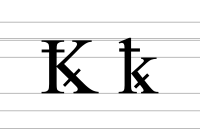| K with stroke and diagonal stroke | |
|---|---|
| ĻØä ĻØģ | |
 | |
| Usage | |
| Type | alphabetic |
| In Unicode | U+A744, U+A745 |
| History | |
| Development | |
| Other | |
K with stroke and diagonal stroke (ĻØä, ĻØģ) is a letter of the Latin alphabet, derived from K with the addition of bars through the ascender and the leg.
This letter is used in medieval texts as an abbreviation for karta and kartam, a document or writ. [1] It was also used as an abbreviation for Kalendas at the end of the tenth century. [2] The same function could also be performed by " K with stroke" (ĻØĆ, ĻØü), or " K with diagonal stroke" (ĻØé, ĻØā). [1]
Capital and small K with stroke and diagonal stroke is encoded in Unicode as of version 5.1, at codepoints U+A744 and U+A745. [3] [4]
- ^ a b "Proposal to add medievalist characters to the UCS" (PDF). 30 January 2006. International Organization for Standardization. Archived from the original (PDF) on 16 July 2011. Retrieved 2 March 2018.
- ^ Cappelli, Lexicon Abbreviaturarum, p. 195.
- ^ "Unicode Character 'LATIN CAPITAL LETTER K WITH STROKE AND DIAGONAL STROKE' (U+A744)". Fileformat.info. Retrieved 2 March 2018.
- ^ "Unicode Character 'LATIN SMALL LETTER K WITH STROKE AND DIAGONAL STROKE' (U+A745)". Fileformat.info. Retrieved 2 March 2018.
- Adriano Cappelli, Lexicon Abbreviaturarum, J. J. Weber, Leipzig (1928).
| K with stroke and diagonal stroke | |
|---|---|
| ĻØä ĻØģ | |
 | |
| Usage | |
| Type | alphabetic |
| In Unicode | U+A744, U+A745 |
| History | |
| Development | |
| Other | |
K with stroke and diagonal stroke (ĻØä, ĻØģ) is a letter of the Latin alphabet, derived from K with the addition of bars through the ascender and the leg.
This letter is used in medieval texts as an abbreviation for karta and kartam, a document or writ. [1] It was also used as an abbreviation for Kalendas at the end of the tenth century. [2] The same function could also be performed by " K with stroke" (ĻØĆ, ĻØü), or " K with diagonal stroke" (ĻØé, ĻØā). [1]
Capital and small K with stroke and diagonal stroke is encoded in Unicode as of version 5.1, at codepoints U+A744 and U+A745. [3] [4]
- ^ a b "Proposal to add medievalist characters to the UCS" (PDF). 30 January 2006. International Organization for Standardization. Archived from the original (PDF) on 16 July 2011. Retrieved 2 March 2018.
- ^ Cappelli, Lexicon Abbreviaturarum, p. 195.
- ^ "Unicode Character 'LATIN CAPITAL LETTER K WITH STROKE AND DIAGONAL STROKE' (U+A744)". Fileformat.info. Retrieved 2 March 2018.
- ^ "Unicode Character 'LATIN SMALL LETTER K WITH STROKE AND DIAGONAL STROKE' (U+A745)". Fileformat.info. Retrieved 2 March 2018.
- Adriano Cappelli, Lexicon Abbreviaturarum, J. J. Weber, Leipzig (1928).